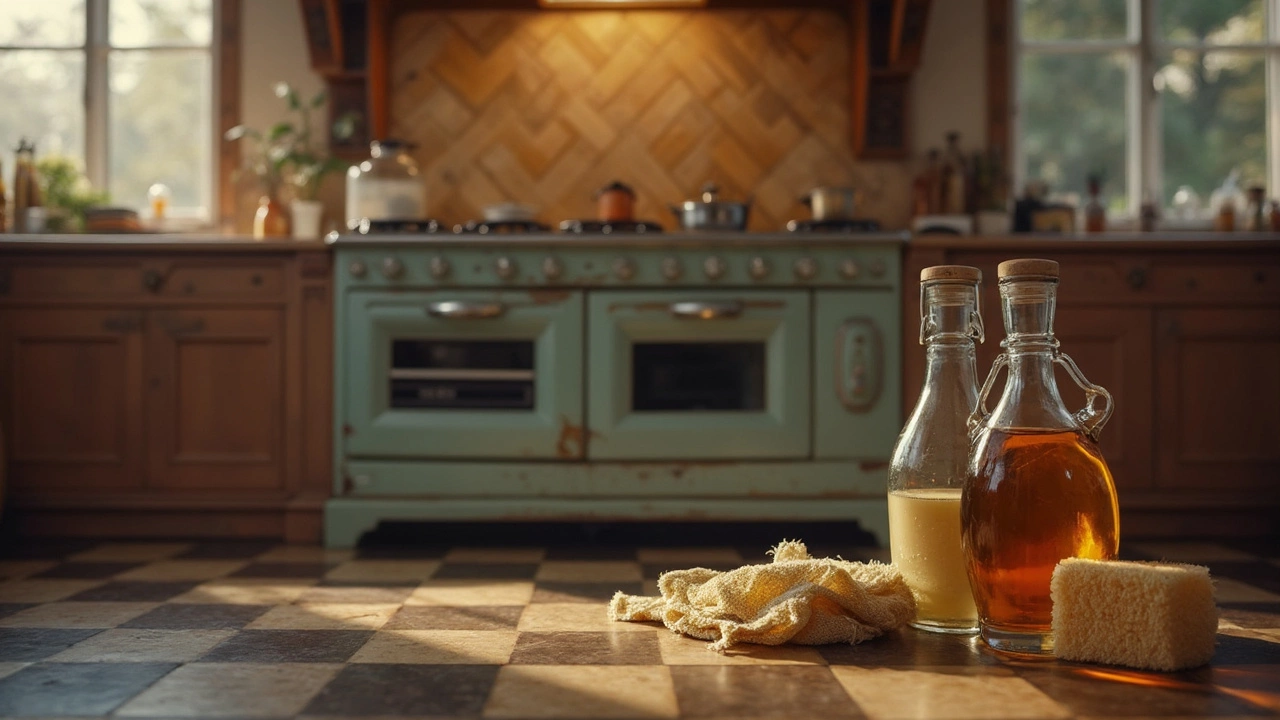Ever looked at your grimy oven and thought, 'Maybe I should just douse this thing in vinegar?' You're not alone. Over the years, vinegar has earned the reputation of a miracle cleaner for just about everything — including ovens. But before you start pouring, let's see if that's really a good idea.
Vinegar's cleaning power mainly comes down to its acidic nature. It's great at dissolving many types of grime, which is why you can find it in countless cleaning recipes. But when it comes to ovens, especially those with older or more delicate surfaces, things might not be so straightforward.
Different materials in your oven can react differently to vinegar. For instance, while stainless steel might handle a gentle vinegar wipe-down, some rubber seals and certain paints might not be too thrilled. The key is understanding what you're dealing with to avoid any lasting damage.
- The Science Behind Vinegar
- Vinegar's Effects on Oven Surfaces
- Best Practices for Cleaning with Vinegar
- Alternatives to Vinegar for Oven Cleaning
- Common Mistakes to Avoid
The Science Behind Vinegar
You might know vinegar as that tangy addition to your salad dressing, but it's a bit of a science hero in the cleaning world too. So what's in it that makes it work? Primarily, it's acetic acid — usually about 4-7% of your regular white vinegar is acetic acid, dissolved in water. It's this acidity that gives vinegar its mighty cleaning powers.
Why does acid matter? Well, acids are great at breaking down organic compounds, which means they dissolve grime, grease, and even rust. That's why vinegar is often a go-to for many oven cleaning tasks. Given that ovens tend to accumulate a fair amount of organic gunk over time, vinegar seems like the natural hero for the job.
Why Vinegar Works on Grease
Grease, made up mostly of fat, interacts interestingly with acids. When vinegar, an acid, is applied to greasy oven walls, the acetic acid can help break down that grease, making it easier to wipe away with a cloth. It's kind of like science class happening right there in your kitchen!
Breaking Down Carbon Deposits
Baked-on messes are often carbonized food particles. Vinegar can assist in softening these deposits, though sometimes it requires a bit of heat to kickstart the process. A warm oven or vinegar solution can work wonders on these stubborn spots.
| Vinegar Type | Acidity Percentage |
|---|---|
| White Vinegar | 5% |
| Apple Cider Vinegar | 4-6% |
| Balsamic Vinegar | 6-7% |
While strong enough to cut through grime, vinegar is gentle on most oven materials. However, always be cautious with repeated use, especially on older or more delicate surfaces, to avoid any unintentional harm.
Vinegar's Effects on Oven Surfaces
Using vinegar for oven cleaning might seem like a no-brainer given its natural cleaning strength, but understanding how it interacts with different oven surfaces is crucial. Let's break it down so you don't end up with a bigger cleaning problem.
Stainless Steel and Metal Parts
Stainless steel is pretty resilient, so if your oven has these metal parts, a vinegar cleaning is generally safe. The acidic properties of vinegar can effectively cut through grease without scratching or dulling the finish. Just make sure to wipe off the vinegar thoroughly to prevent any potential dulling over time.
Glass
The glass on your oven door is another area where vinegar shines. It cuts through the baked-on grime and fingerprints like magic, leaving your glass shiny and spotless. However, always follow with a dry cloth to prevent streaks from forming.
Rubber Seals
While vinegar is a champ on metal and glass, it can be a bit of a villain when it comes to rubber seals. Regular exposure to vinegar's acidity can cause them to degrade and lose their flexibility over time. Be cautious and maybe stick to warm water and mild soap for those.
Enamel Coatings
Finally, there's enamel. Most modern ovens come with an enamel coating inside. While vinegar can spot-clean enamel quite effectively, leaving it on too long might lead to a dull finish. A quick wipe is your best bet here.
- Tip: Always do a patch test on a small area before committing to a full clean.
- Tip: Consider following up with a water rinse to neutralize any residual acidity.

Best Practices for Cleaning with Vinegar
Cleaning your oven with vinegar can be quite effective if you do it right. Let's break down some of the best ways to use this natural cleaner to make sure your oven stays in top shape without any hiccups.
1. Dilute for Safety
While vinegar is a great cleaner, it's acidic enough that full strength might be a bit much for some surfaces. It's best to start with a mix of half vinegar and half water. This keeps it strong enough to clean but gentle enough not to damage your oven.
2. Spot Test First
Before you go all out, try your vinegar solution on a small, hidden area inside the oven. This helps make sure there won't be any unexpected reactions, especially if your oven has unique materials or finishes.
3. The Wiping Technique
Don't just sprinkle and forget. Moisten a cloth or sponge with the vinegar mix and wipe down the surfaces. This way, you'll have more control over where the cleaner goes and how much you're using.
4. Tackle Grease Carefully
Vinegar does wonders for cutting through grease. For those stubborn spots, spray the solution and let it sit for about 10-15 minutes before wiping it away. For extra tough areas, consider using a bit of baking soda together with the vinegar.
5. Mind the Oven's Interior
Focus on the safe-to-clean spots. Avoid the heating elements and any gas vents if you're working with a gas oven. These parts are sensitive, and vinegar may not be the right fit for them.
By following these tips, you can ensure that your oven cleaning session will be not only effective but also safe for your appliance. The goal is to maintain your oven in great condition without having to bring in harsh chemicals.
Alternatives to Vinegar for Oven Cleaning
If you're worried about using vinegar or it's just not cutting it for your oven cleaning needs, there are plenty of other options to explore. Sometimes you need something with a little more oomph, or perhaps you're just looking to switch things up. Let's dive into some alternative solutions that can help keep your oven spotless without the vinegar.
1. Baking Soda and Water Paste
Baking soda is a classic go-to for tough stains. It's mildly abrasive, which makes it perfect for scrubbing off tough spots without scratching surfaces.
- Mix together a thick paste of baking soda and water.
- Spread it evenly across the oven grime.
- Let it sit overnight for best results.
- Wipe off with a damp cloth, and your oven should look much better.
2. Lemon Juice
Lemon juice is another safe cleaning option. Its citric acid can help break down grease and it's a natural deodorizer too!
- Cut a couple of lemons in half and squeeze the juice into a baking dish.
- Add some water and place the dish in a warm oven for about 30 minutes.
- Let it cool, then wipe down the interior. The grime should loosen quite a bit.
3. Commercial Oven Cleaners
For those times when natural methods aren't enough, there's always the option of grabbing a commercial oven cleaner. They're usually more powerful and designed to tackle heavy-duty gunk.
- Just make sure to follow the instructions on the label for safety.
- Keep the kitchen well-ventilated while using them to avoid inhaling harsh fumes.
4. Steam Cleaning
Some newer ovens even come with a steam-cleaning setting.
- Simply fill the designated reservoir with water and select the steam cleaning option.
- The steam will loosen any caked-on food and make it easier to wipe away.
Switching up your kitchen tips doesn’t have to mean compromising effectiveness. With these options, you can keep your oven looking pristine while keeping risks at bay.

Common Mistakes to Avoid
While cleaning your oven with vinegar might seem like a straightforward task, there are some classic blunders that folks often make. Dodging these can save your oven from unnecessary wear and tear.
Using Too Much Vinegar
More isn't always better. Drenching surfaces in vinegar can lead to damage, especially if there are sensitive areas in your oven. Try to use moderate amounts of vinegar mixed with water instead, and test it on a small section first.
Ignoring Material Specifics
Different surfaces react in different ways. Stainless steel might be fine, but rubber seals and some coatings can degrade over time when exposed to vinegar. Check your oven's manual if in doubt.
Skipping the Rinse Step
Leaving vinegar residue on oven parts can lead to corrosion or a lingering acid smell. Always wipe it down thoroughly with a damp cloth afterward and make sure that all traces of vinegar are removed.
- Do use vinegar sparingly on stainless steel surfaces.
- Don't soak seals or electronic components.
- Do conduct a patch test on hidden areas before diving right in.
Misjudging Stains
Some folks believe vinegar alone can tackle the toughest grime, but that's not always true. If you're facing caked-on gunk, consider a safe cleaning alternative specifically designed for tough stains instead of over-relying on vinegar.
A little knowledge and care go a long way in making sure your cleaning efforts don't accidentally damage one of your kitchen's most valuable appliances.
